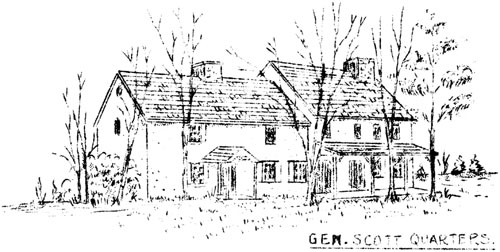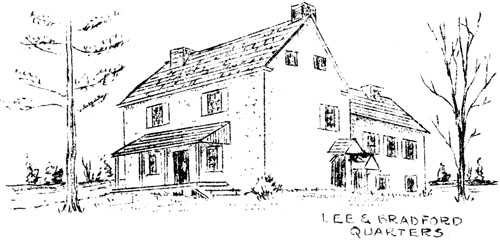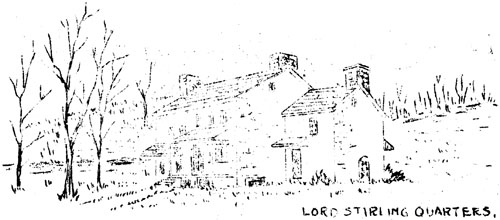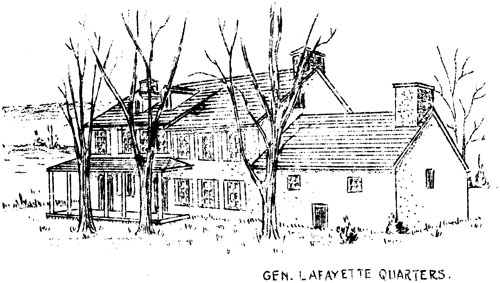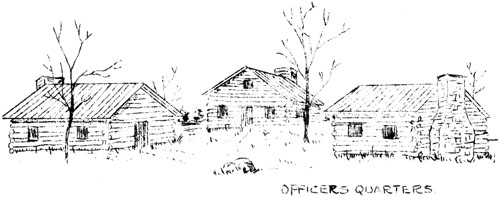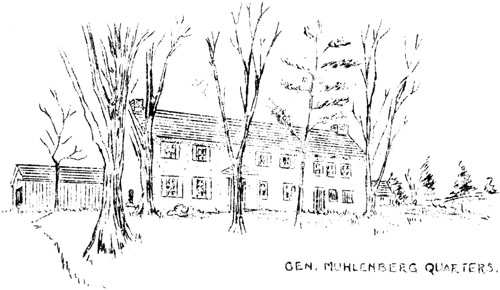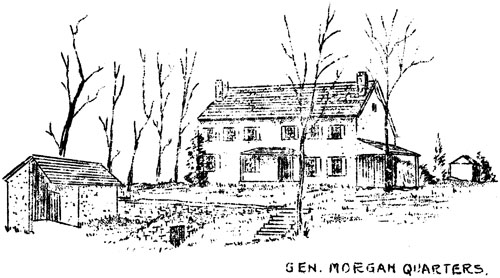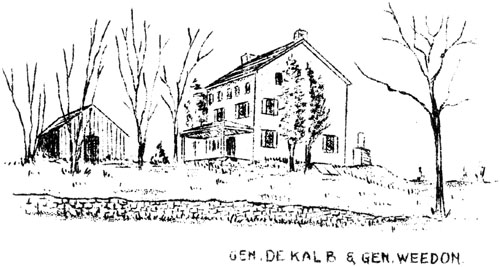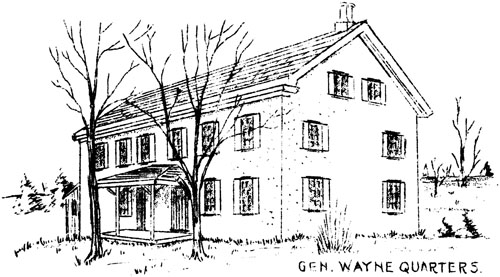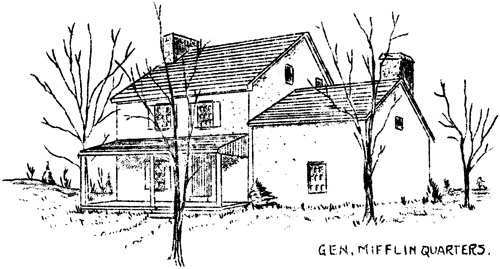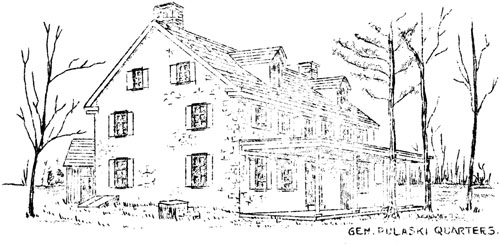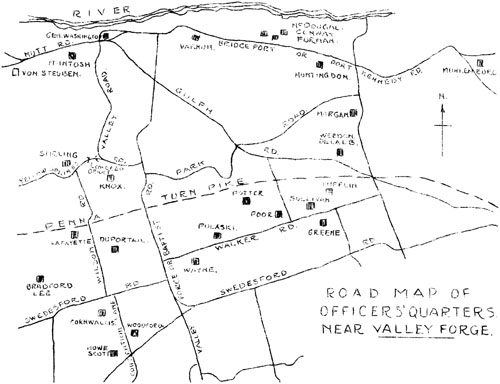|
Home : Quarterly Archives : Volume 8 |
Tredyffrin Easttown Historical Society |
|
Source: April 1954 Volume 8 Number 2, Pages 28–48 American officers quarters at Valley Forge During the encampment of the American Revolutionary Army at Valley Forge the winter of 1777 - 78 the higher officers - mainly of the rank of brigadier general and upwards - were quartered in the houses of the farmers in the region. All of these were well-built stone houses, and most of them are still standing. Seven of them overlook the East Valley Creek, twelve front on Trout Run. At least three - those of Scott, Woodford and Muhlenberg - were outside of the sentinel line. The order of the twenty-three quarters herein described is that which was taken on a pilgrimage of this History Club on April 11, 1937, leaving from the Tredyffrin-Easttown High School building. The building of the new Turnpike has isolated some of the Quarters and rendered the former order impossible; it has therefore been slightly changed. These quarters are often incorrectly referred to as "headquarters," a term which is properly restricted to the quarters of General Washington. The illustrations drawn by Franklin W. Wandless are from photographs taken by L. A. Sampson in 1902. They therefore show the houses as they appeared a half century ago. GENERAL WASHINGTON Although it was cold and snowy weather at Valley Forge in 1777, General George Washington stayed in his tent until the last of the log huts was built when he moved into the home of Isaac Potts, situated at the junction of the Schuylkill River and the Valley Creek. The American Army expected that the British would come up the Schuylkill River, and so placed many of the quarters as close to the river as possible. The house is preserved as one of America's most historic shrines. It has been furnished as far as possible in original condition, is open to the public, and visited by pilgrims from the country over. Isaac Potts was a member of the Society of Friends. He is the one who is said to have seen Washington at prayer. Mrs. Washington joined the General at the Potts house and spent a busy winter trying in her way to help to care for the cold and hungry soldiers. BRIGADIER GENERAL SCOTT Brigadier General Charles Scott occupied the house of Samuel Jones at the northwest corner of Contention Lane and State Road. The original building burned in 1921 and was rebuilt by Mr. and Mrs. Paul Fleer in 1925. The west end was the only part not destroyed by fire. The original building faced the south and was in three sections. The central section was the oldest and consisted of two rooms upstairs and two rooms downstairs. The east and west sections were added later. The old log barn was erected in the early 1700's and the stone part of the barn and probably the springhouse and cattle shelter were built in 1802. Trout Run, which ambles through this property, was diverted from its original course to a bed nearer the house to provide water for the people who lived there. This tiny stream was always full of lovely big trout. In 1828 Samuel Stearns purchased this property and it was in the family until Abraham Latch built his new home on Conestoga Road in 1900. This new house was built of grey stone which was quarried from the old farm. This farm must have been the site of an Indian camp as the Latch boys picked up many Indian arrowheads and hatchets. General Scott commanded a brigade of Virginia and Pennsylvania troops.
Gen. Scott Quarters BRIGADIER GENERAL WOODFORD Brigadier General William Woodford's quarters were in the home of Samuel Richards, situated on Contention Lane just south of the present Route 202. This charming old farmhouse is now the home of William McCullom. As you drive into the lane you come first to the barn and then to the house; further on are the flower gardens. Lovely trees and shrubbery surround the house. The eastern wing of this old house was sturdily erected by Rowland Richards so that his family would have maximum protection against the Indians. The two western additions were apparently constructed at the same time; they are larger than the small eastern wing which was built about 1708. In the old kitchen is a huge fireplace flanked on one side by cubbyholes where the family kept its gin, and on the other side is the old oven where the bread was baked. The legend handed down through the years relative to the oven is that at one time the stone slab on the bottom of this oven broke. A member of the Richards family replaced this stone with a tombstone from the Great Valley Cemetery. In putting in the new stone the inscribed side was placed uppermost so the bread from then on came out of the oven with "Here lies so-and-so-" on it. The McCulloms have preserved this old place in much of its original charm and simplicity. They point out to the visitor such items of interest as the old fireplace, the old sink by the window, and the old door with its oak tumbler lock, as well as articles found around the place which serve as reminders of early inhabitants. Washington's generals met at Woodford's quarters occasionally. We have the following quotation from the Orderly Book of General Weedon: "March 20, 1778, the Brigadiers and Officers commanding brigades are desired to meet at Gen'l Woodford's Quarters on Tuesday morning, 10 0clock, to regulate ye price of ye following articles:- Rum, French Brandy, Jinn, Spirits and Cyder Royal.." General Woodford was appointed Colonel of the 2nd. Virginia Regiment; he commanded a brigade of Virginia Troops.
General Woodford Quarters GENERAL LEE AND COLONEL BRADFORD Major General Charles Lee's quarters were also the quarters of Colonel Thomas Bradford. It is the small farmhouse on Chesterbrook Farm which is the property of Mrs. J. Packard Laird who resides in the large house nearby. At the time it was occupied by Generals Lee and Bradford it was the home of David Havard. The farm may be entered from Swedesford Road just east of where the road crosses the Trenton Cutoff, or from the Parson Currie Road. General Lee was known as a cynical and erratic officer. He ranked senior to all Major generals, but after the Battle of Monmouth he was dismissed from the army. Colonel Bradford is said by one authority to have been Muster General, and by another the Commissary Officer of prisoners.
Lee & Bradford quarters
Lord Stirling quarters GENERAL LORD STIRLING Major General Stirling's quarters are on Yellowsprings Road just west of the covered bridge at Valley Forge Park. It was then the home of Rev. William Currie and his daughter and son-in-law Mr. and Mrs. Thomas Walker, and is now the home of Mr. and Mrs. Robert C. Ligget. Most of the features of the Revolutionary period have been retained in the restoration of the house, and Mr. and Mrs. Ligget have one Early American room which is known as the Parson Currie Room. In this room is the big old fireplace which was probably used to cook the meals for General and Mrs. Stirling. General William Alexander Stirling, a veteran of the French and Indian War, had married a daughter of Phillip Livingston of New York, and he was one of the fortunate officers to have his wife join him during the stay at Valley Forge. General Stirling had seen fit to renounce his claims to a Scotch peerage as Earl of Stirling. He commanded a division of Conway's Pennsylvania Brigade and Duportail's Engineers, forming the wing of the Army to the west. From Weedon's Book: "All ye Major and Brigadier Generals are to meet at Ld. Stirling's quarters at l0 oclock tomorrow A.M. (March 4, 1778) when they will take into consideration a claim of Rank by Gen. Muhlenberg, Weeden, Woolford & Scott according to case stated and such papers as are referred to it, which will be transferred and reported, their opinion as to ye proceedings, they shall hold with respect to each other." It was at Lord Stirling's quarters that a court of Inquiry (of which Lord Stirling was president) was held "to inquire into the conduct of Brig. Gen. Wayne" concerning his neglect of intelligence of the enemy's intention, (from which charge he was acquitted). From Weedon's Orderly Book, dated Oct. 12, 1777: "All parties and witnesses concerned in the charge against Gen. Wayne are to attend at Lord Stirling's quarters tomorrow morning at 9 oclock." GENERAL MARQUIS DE LAFAYETTE Major General Marie Jean Paul Roch Yves Gilbert Motier Lafayette's quarters are located on the Wilson Road on the south side of Valley Creek. It was then the home of Samuel Havard and is now part of the University of Pennsylvania property. The last family to reside at the quarters (as it is now vacant) was the Henry R. Wilson family, which is one of the old families of the Valley. Tradition says that Lafayette occupied but two rooms in the quarters. At the time the army was at Valley Forge this property was occupied by Samuel Havard who was a bachelor; his two sisters kept house for him, and probably helped Lafayette with his housekeeping. The room on the first floor has the original fireplace which Lafayette probably used - if tradition is correct.
Gen. Lafayette quarters GENERAL KNOX The home of Mr. and Mrs. Robert M. Tindle, Valley Forge Farm, was, during the encampment at Valley Forge, the quarters of Brigadier General Henry Knox, one of Washington's most trusted advisors. His services throughout the war were of great value to the American cause. He commanded the much needed artillery and brought it to a high state of efficiency. This beautifully set old house with its rich historical associations is surrounded with stately trees. It is entered through a spacious central hall, which loads to the terrace across the back of the house that commands a magnificent view of Valley Creek and of the fine rolling farmland and countryside. On the right of the en trance hall is the dining-room and service quarters, which are in the original part of the house. The unusual diamond-paned cupboards in the dining room are said to be original. On the left of the hall is the living room,which appears to have been two rooms thrown together to make a gracious well-proportioned room. Because the Knox quarters were much larger than Washington's it is believed that many important meetings took place here. Martha Washington is said to have spent much time here with Mrs. Knox during the encampment, rolling bandages, and mending and sewing for the soldiers.
Gen. Knox quarters GENERAL COUNT DUPORTAIL Brigadier General Duportail's quarters were then the home of John Havard, now on the University of Pennsylvania farm. The original house is said to have been built in 1740. It is represented by the dining room which was made by removing the partition between the old parlor and the kitchen on the lower floor, and by the bedrooms above. This was the house known to Duportail. It is a two-story building with two pitched roofs. The present house exhibits three distinct periods of architecture. To reach this house one leaves Lafayette's quarters and follows the road that leads towards Route 202; it is almost inaccessible from Wilson Road. Count Louis Chevalier Duportail, a Frenchman, was in command of the Engineers on the west side of Valley Creek. GENERAL MCINTOSH The quarters of Brigadier General Lachlan McIntosh are reached by crossing the concrete bridge to Nutt Road and then going between a private drive and the P.O.S.A. Hall, then the home of Joseph Mann. The quarters themselves have been destroyed, and today are marked only by a corner column of masonry covered with ivy. General McIntosh commanded a brigade of nine skeleton North Carolina regiments that were stationed on the northern slope of the rear hill above his quarters. He succeeded Brigadier General Nash who was killed at the Battle of Germantown. GENERAL BARON VON STEUBEN A two-story detached house, formerly known as the Slab Tavern, was the quarters of Major General Frederick William Baron Von Steuben. The house now belongs to the Charles E. Hires Company and lies in the rear of a high brick house. To reach it, one continues west on Nutt Road to a point above the Methodist Church, then turn left to Irish Road, and left again. Von Steuben was Inspector General of the Continental Army. It was due to the efforts of this old Prussian drillmaster that the army was developed into a trained group of fighting men. GENERAL VARNUM Brigadier General James M. Varnum's quarters, located on the Port Kennedy Road in the Valley Forge Park, is a two-story grey stone building. At the time it was occupied by General Varnum it was the home of David Stephens. It is now maintained as a part of Valley Forge Park. General Varnum commanded the Rhode Island Brigade near the Star Redoubt, which was then known as Stephen's Fort. Fort Huntingdon stands nearby and was then a part of the same property which ran to the Schuylkill River where it connected with Sullivan's Bridge. The Star Redoubt, a magazine fort, lies directly north of the David Stephens house. A spy was supposed to have been hung on this property during the time of the encampment. Most of the Courts Martial were held at Varnum's quarters. Quote from Weedon's Orderly Book dated Jan. 17, 1778: "The Brigadiers and Officers commanding Brigades are to meet at Gen'l. Varnum's quarters to consult and agree upon proper and speedy measures to exchange raw hides for shoes. They will as soon as possible critically examine into the state and condition of the arms in the respective brigades, and get those out of repair put in order as soon as possible and consult upon the most speedy method of procuring a sufficient number of proper sized bayonets to supply the deficiencies. The Gen'l desires that they will likewise agree upon the most proper and speedy means to have all the officers in their Brigades furnished with half spikes agreeable to Gen'l orders issued Dec. 22nd." General Weedon's Orderly Book states: "Feb. 8th, 1778. "The general officers are requested to meet at 10 oclock tomorrow at Gen. Varnum's quarters to take into consideration the propriety of altering the present rations. The Commissary General proposes that instead of the rations heretofore issued there should be issued a pound & a half of flour, one of beef, one and 3/4 salt pork & a certain quantity of spirits. Mr. Blaine will attend the meeting." Weedon's Orderly Book, March 27th, 1778: "Brigadiers and officers commanding Brigades meet at Gen. Varnum's Quarters at 11 oclock to receive assignments for the completion of the Interior line of Defense."
Gen. Varnum quarters GENERALS McDOUGAL AND CONWAY AND COLONEL FORMAN Brigadier Generals Alexander McDougal and Thomas Conway, Colonel David Forman, and, for a time, General von Steuben were quartered in huts on the north side of Bridgeport Road between the Gate house and Memorial Church. These huts were east of Varnum's quarters and west of Huntingdon's quarters on the opposite side of the road.
Officers quarters GENERAL HUNTINGDON Brigadier General Jedediah Huntingdon's quarters were just beyond the Valley Forge Memorial Chapel, across the road. It was acquired by the Park Commission in 1917 and is now a part of Valley Forge Park. At the time of the Revolution it was the home of Zachary Davis, a tenant of David Stephens. The original house was destroyed in 1812. The only original structure is the springhouse. On this property is the grave of John Waterman, a commissary officer under General Varnum. General Jed Huntingdon commanded the Connecticut brigade, inner line. His troops were better dressed, healthier and better clothed than any others. He was always looking out for his men and was the first to provide huts for them. A number of huts were built right on this property. In one of them Von Steuben lived until he moved to Slab Tavern. General Huntingdon allocated a doctor to each regiment.
Gen. Huntingdon quarters GENERAL MUHLENBERG General Muhlenberg's quarters was then the home of John Moore, who bought the land on which the house stands in 1709; the house was built soon after that. It stands well back from Moore Road; the grounds slope to Mashilmac Creek. The farm was divided between Moore's two sons Mordecai and John in 1790. Mordecai bought 128 acres on King of Prussia Road. This house is now called "Winter Quarters Farm" and is owned by Mr. and Mrs. Alexander lrwin. Brigadier General John Peter Gabriel Muhlenberg was a Lutheran Pastor in Woodstock, Virginia, and is the minister who stood in his pulpit and said "There is a time for all things - a time to preach and a time to pray. But there is also a time to fight, and that time is now come." He commanded the Eighth Virginia Regiments. Muhlenberg's brigade consisted of the First, Fifth, Ninth and Thirteenth Regiments of the Virginia Line. It was a part of General Greene's Division.
Gen. Muhlenberg's quarters COLONEL MORGAN Woodman states that Colonel Daniel Morgan's quarters were at the home of Mordecai Moore, situated at Morgan's Corner near Radnor on a high bluff overlooking Trout Run at the eastern extremity of the old encampment. Colonel Morgan commanded an outpost in Radnor Township, and it is probable that his riflemen manned John Moore Fort, since his quarters were nearby. He had worked his way through Pennsylvania to the Virginia frontier. Here he was a teamster in the quartermaster's department during Braddocks campaign against the French and Indians. Morgan's troops were backwoodsmen from Virginia and Pennsylvania and were noted sharpshooters; they were generally found in the most strategic place in the line of march. He was not at his quarters all of the time and is said to have gone home to Virginia during the winter.
Gen. Morgan quarters GENERALS BARON DE KALB AND WEEDON Major General Johann, Baron de Kalb, and Brigadier General George Weedon had their quarters in the home of Abijah Stephens, on the site of the present home of Mr. and Mrs. Frederico Franco Mauck, "East Watch", at Port Kennedy. The original house was nearer the creek than the present one, and was burned down. The springhouse is dated 1802. Dubuyson, a French officer, occupied a cave in the present yard. This lovely house was altered and restored about forty years ago by John R. K. Scott. Thomas Wyatt wrote in Graham Magazine, 1850: "In 1755 de Kalb was filling an inferior station in the Quartermastergeneral's department in the Imperial Army of France. In 1777, when the news of the war of the American Revolution reached France, the youthful Lafayette, accompanied by the Baron de Kalb, left France and offered their assistance in the struggle for independence. They arrived early in July, 1777 and presented their papers to Congress, which gave them commissions as major generals, bearing the date of July 31st. 1777. De Kalb received eleven bayonet wounds in the action near Camden, South Carolina. Lieutenant Colonel de Buyson saw his prostrate general in the act of falling and, stretching his arms over the fallen hero, exclaimed "Save the Baron de Kalb"! De Kalb lived only three days and, when he lay dying, said, "I thank you for your generous sympathy, but I die the death 1 always prayed for - the death of a soldier fighting for the rights of man." This was in 1780, he having served the Colonies three years. He died at the age of 48. General Weedon resigned from the army when Congress promoted officers of lower rank over his head.
Gen. de Kalb & Gen. Weedon GENERAL SULLIVAN Major General John Sullivan was quartered at Mifflin house on Richard Road, which was then the home of Thomas Waters. This land is now owned by Mrs. Donald W. Darby, daughter of John R.K. Scott. The house now standing is not the original but was built about 1820 on the same site. At the back of the property is Trout Run. It was General Sullivan who built the bridge over the Schuylkill near the Star Redoubt. He was the presiding officer at the court martial that tried Anthony Wayne, and the trial was held, at his request, at General Sullivan's quarters, October 25, 26, 27 and 30, 1777. Generals Muhlenberg, Weedon, Conway and Huntingdon, and Colonels Stephens, Dayton, Mc Clemachan, Stewart, Bradley, Davis, De Hart and Thackston were the other members. After investigating the evidence, the court voted unanimously to acquit Wayne. The charge against Wayne was "that he had timely notice of the Enemy's intentions to attack the troops under his command on the night of September 20th, ult., and that notwithstanding that intelligence, neglected making a Disposition until it was too late; either to annoy the Enemy, or make a Retreat without the utmost Danger and Confusion." General Sullivan was born in New Hampshire in 1740. He was a very active man, and officers' meetings were frequently held in his quarters. Thus we find these entries in the Orderly Book. "The Gen'l Officers and Officers Commanding Brigades are desired to meet tomorrow Jan. 21 at 10 oclock in order of considering the expedience of opening a publick Market in camp." The first market was held at the Stone Chimney Post, February 9th., 1778. "Feb, 15th, 1778. The Gen'l Officers are desired to meet at Gen. Sullivan's quarters tomorrow morning at 10 0clock to take into consideration and determine upon the memorial of the Cap't of the Penna. Line against the promotion of Michael Ryan Eng. to the majority of the Regt. and to settle the Rank of Capt. Green." (or Grears; it is not clear which. Ed.) "Feb. 23, '78, Brigadiers and Officers Commanding Brigades to meet at Sullivan's qts. tomorrow morning at 10 A. M. to make a just distribution of cloathing." GENERAL WAYNE General "Mad" Anthony Wayne's quarters are situated on the place now known as Manysprings Farm, located on Walker Road just east of the Baptist Road, now known as Route 83. This house has been unoccupied for some time but is well worth visiting just to see some of the finest boxwood in this part of the country. It is owned by Mr. Freedman. At the time this property was occupied by Anthony Wayne it was the home of Joseph Walker and his 18-year-old bride who was a cousin of Wayne's. The Walker family has long been considered one of the oldest families in the Valley, and even now you could not drive far without meeting with one of the descendants of the Walker family. Colonel T. Robinson, Major Benjamin Fishbourne, and Ryan were also quartered at the Walker home with Wayne. Brigadier General Wayne commanded a division of Pennsylvania troops on the outer line , but he was seldom stationary, since he made raids in New Jersey and elsewhere, bringing in beef on the hoof for the army. Once when a Court Martial was being held, and two soldiers were to have been shot, Mrs. Walker called Wayne from the room and said to him;" These men are young and cold and must not be shot," after which Wayne entered the room and the soldiers were not convicted.
Gen. Wayne quarters
Gen. Mifflin quarters GENERAL MIFFLIN Major General Thomas Mifflin's quarters were at the home of Thomas Godfry, a tenant of the owner Thomas Waters. Mifflin was Quartermaster General for a time at Valley Forge. The confusion and derangement of the Quartermaster's Department while filled by General Mifflin was a source of perpetual embarrassment to Washington. Mifflin, while capable of doing his duty, was hardly ever at hand. He was dissatisfied with the way Washington was conducting the war and conspired to remove him. The plan failed, however, and Mifflin was removed from the War Board in 1770. On December 31, 1790 he became Pennsylvania's first Governor and served until December 17, 1798. He died January 20, 1800. GENERAL POOR During the occupancy of Valley Forge by Washington's army in the winter of 1777-78, Brigadier General Poor used as his quarters a farm house that stands today, on the west side of Thomas Road between Walker and Richard Roads. It was then the home of Benjamin Jones, and known as "Little Place Farm." It is now owned and occupied by Mr. and Mrs. Joseph M. McCready. The house was built on a land grant from William Penn to the Walker family, and was for many years the home of Nathan Walker. The oldest part of the house is a three story stone building of six rooms, and the date stone is either 1740 or 1748. The curved stairway is closed. The addition was built between 1812 and 1825. The house has original floors, hardware and window panes. In the library hangs a small Gilbert Stuart portrait of Washington, and a portrait of Enoch Poor made by the present owner of the house. General Enoch Poor (June 21, 1736 - Sept. 8, 1780) was born at Andover, Mass., and died while still in the service at Paramus, N.J. The circumstances of his death are shrouded in mystery. One theory is that he perished of a fever; another is that he was killed in a duel by a junior officer. General Poor commanded a brigade of New Hampshire and New York troops. GENERAL POTTER Brigadier General James Potter's quarters were north of Poor's, just west of the Thomas Road. The original house, the home of William Godfry who rented it from Thomas Waters, was about forty yards northwest of the present house, now the home of Mr. and Mrs. James M. Large. Potter was from Cumberland County, and during the French and Indian War had served as an ensign in the Battalion of Lieutenant Colonel Armstrong. The General is described as a stout, broad-shouldered, plucky, active man, five feet nine inches in height, of dark complexion and an excellent representative of the Scotch-Irish race. His judgment and energy overcame his lack of education. He commanded the Pennsylvania Militia. Previous to coming to Valley Forge he had been ordered to collect provisions and clothing, especially shoes, stockings and blankets, and to remove and secrete all grinding stones from the mills in the neighborhood of Chester and Wilmington. It is known that Colonel Clark accompanied Potter part of the time while he was chief of the secret service, and that his spies, as opportunity permitted, dressed themselves as farmers, and entered the city with loads of horse meat butchered from war steeds shot under British or Hessian Cavalrymen, which they sold as prime beef for British gold, while making observations. GENERAL PULASKI Brigadier General Casimir Pulaski's quarters was then the home of Margaret Beaver; a widow, many descendants of the Beaver family are still living in the vicinity. Known as "Brookmead Farm," it is now the home of Mr. and Mrs. Edward Law. The property was previously owned by Mr. and Mrs. Frank Graham Thomson. The original building was built about 1715 or 1720. It is made of Pennsylvania field stone with walls two feet thick. The original house had two rooms on the first floor with a hall and unusually wide stairs, two large and one small room on the second floor and the same on the third floor. The windows were very narrow and have since been made into casement windows. There is one fireplace on the first floor of the original building now. It is believed by Mrs. Law that there were originally two corner fireplaces on the first floor, but these had been removed many years ago. There have been three additions to the original building. The dining room was added about 1800 and this has a beautiful colonial fireplace. The final addition, the kitchen, was made after 1900. This was the place where Devault Beaver, age 21, son of Margaret Beaver, shot a soldier milking his cow. Devault lived to be 81 and is buried in the Old Eagle School burying grounds. His defense was that he had complained to Wayne, and Wayne said "Shoot." General Pulaski was a Pole in charge of a Foreign Legion. He died in the assault on Savannah. General Poor also was here for a time.
Gen. Pulaski quarters GENERAL GREENE This New-England-born Quaker is usually conceded to have been next to Washington in ability among the American generals. Supplied with inadequate troops, it has been said of him that he never won a battle nor lost a campaign. Always dependable, perhaps his greatest work was in the south toward the close of the war. In the fall of 1777 he was directed by Washington to examine and report upon the forts on the Delaware and then to retire to Valley Forge. His quarters were in the Isaac Walker home "Rehobeth" on the north side of Route 202 west of Eagle School Road. To reach then turn north from Route 202 at Eagle School Road and take the lane leading to the west at a point a short distance north of Valley Friends Meeting. It is a two-and-a half story house. The original house was built in 1708; this is now the east wing of the house. A large addition was built by Isaac Walker in 1799 and more was added in 1899 by Charles Walker. The house is now owned by J. Edgar Hires of Philadelphia. Major General Nathaniel Greene was born in New England in the town of Warwick, situated at the head of a small stream known as Potowhommett. His father was a Quaker preacher and his early knowledge all came from one book, the Bible. His mother died when ho was ten years old. He married the niece of Governor Green's wife on July 20, 1774, and she was one of the several wives who joined the officers at Valley Forge. General Greene commanded Muhlenberg's and Weedon's brigades of Virginia troops and the center or reserve of the array. Upon the resignation of General Thomas Mifflin of Pennsylvania, General Greene took over the management of the Quartermaster's department to the great satisfaction of the army. His troops were pronounced as the best disciplined men in the service by a member of Washington's staff. General Greene presided at the trial of Major Andre. TopSources of Material Selected Orders from General Weedon's Orderly Book, Valley Forge, 1777-78. History of Valley Forge Encampment by Henry Woodman, 1850. Quarterlies of the Tredyffrin-Easttown History Club. Research done by several members
Road map of officers' quarters near Valley Forge |
